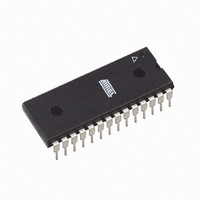ATMEGA8L-8PC Atmel, ATMEGA8L-8PC Datasheet - Page 158

ATMEGA8L-8PC
Manufacturer Part Number
ATMEGA8L-8PC
Description
IC AVR MCU 8K LV 8MHZ COM 28-DIP
Manufacturer
Atmel
Series
AVR® ATmegar
Specifications of ATMEGA8L-8PC
Core Processor
AVR
Core Size
8-Bit
Speed
8MHz
Connectivity
I²C, SPI, UART/USART
Peripherals
Brown-out Detect/Reset, POR, PWM, WDT
Number Of I /o
23
Program Memory Size
8KB (4K x 16)
Program Memory Type
FLASH
Eeprom Size
512 x 8
Ram Size
1K x 8
Voltage - Supply (vcc/vdd)
2.7 V ~ 5.5 V
Data Converters
A/D 6x10b
Oscillator Type
Internal
Operating Temperature
0°C ~ 70°C
Package / Case
28-DIP (0.300", 7.62mm)
Lead Free Status / RoHS Status
Contains lead / RoHS non-compliant
Other names
ATMEGA8L8PC
Available stocks
Company
Part Number
Manufacturer
Quantity
Price
Company:
Part Number:
ATMEGA8L-8PC
Manufacturer:
TI
Quantity:
2 154
- Current page: 158 of 302
- Download datasheet (6Mb)
Electrical
Interconnection
Data Transfer and
Frame Format
Transferring Bits
START and STOP
Conditions
158
ATmega8(L)
As depicted in
age through pull-up resistors. The bus drivers of all TWI-compliant devices are open-drain or
open-collector. This implements a wired-AND function which is essential to the operation of the
interface. A low level on a TWI bus line is generated when one or more TWI devices output a
zero. A high level is output when all TWI devices tri-state their outputs, allowing the pull-up resis-
tors to pull the line high. Note that all AVR devices connected to the TWI bus must be powered
in order to allow any bus operation.
The number of devices that can be connected to the bus is only limited by the bus capacitance
limit of 400pF and the 7-bit slave address space. A detailed specification of the electrical charac-
teristics of the TWI is given in
different sets of specifications are presented there, one relevant for bus speeds below 100kHz,
and one valid for bus speeds up to 400kHz.
Each data bit transferred on the TWI bus is accompanied by a pulse on the clock line. The level
of the data line must be stable when the clock line is high. The only exception to this rule is for
generating start and stop conditions.
Figure 69. Data Validity
The Master initiates and terminates a data transmission. The transmission is initiated when the
Master issues a START condition on the bus, and it is terminated when the Master issues a
STOP condition. Between a START and a STOP condition, the bus is considered busy, and no
other master should try to seize control of the bus. A special case occurs when a new START
condition is issued between a START and STOP condition. This is referred to as a REPEATED
START condition, and is used when the Master wishes to initiate a new transfer without relin-
quishing control of the bus. After a REPEATED START, the bus is considered busy until the next
STOP. This is identical to the START behavior, and therefore START is used to describe both
START and REPEATED START for the remainder of this datasheet, unless otherwise noted. As
depicted below, START and STOP conditions are signalled by changing the level of the SDA
line when the SCL line is high.
SDA
SCL
Figure 68 on page
“Two-wire Serial Interface Characteristics” on page
Data Stable
157, both bus lines are connected to the positive supply volt-
Data Change
Data Stable
2486Z–AVR–02/11
238. Two
Related parts for ATMEGA8L-8PC
Image
Part Number
Description
Manufacturer
Datasheet
Request
R

Part Number:
Description:
8-bit AVR with 8K Bytes In-System Programmable Flash
Manufacturer:
ATMEL [ATMEL Corporation]
Datasheet:

Part Number:
Description:
IC AVR MCU 8K 8MHZ 3V 32-QFN
Manufacturer:
Atmel
Datasheet:

Part Number:
Description:
IC AVR MCU 8K 8MHZ 3V 28DIP
Manufacturer:
Atmel
Datasheet:

Part Number:
Description:
IC AVR MCU 8K LV 8MHZ COM 32TQFP
Manufacturer:
Atmel
Datasheet:

Part Number:
Description:
IC AVR MCU 8K LV 8MHZ IND 32TQFP
Manufacturer:
Atmel
Datasheet:

Part Number:
Description:
IC AVR MCU 8K LV 8MHZ IND 28-DIP
Manufacturer:
Atmel
Datasheet:

Part Number:
Description:
IC AVR MCU 8K LV 8MHZ COM 32-QFN
Manufacturer:
Atmel
Datasheet:

Part Number:
Description:
IC AVR MCU 8K LV 8MHZ IND 32-QFN
Manufacturer:
Atmel
Datasheet:

Part Number:
Description:
MCU AVR 8KB FLASH 8MHZ 32TQFP
Manufacturer:
Atmel
Datasheet:

Part Number:
Description:
MCU AVR 8KB FLASH 8MHZ 32QFN
Manufacturer:
Atmel
Datasheet:

Part Number:
Description:
IC MCU AVR 8K 5V 8MHZ 32-TQFP
Manufacturer:
Atmel
Datasheet:

Part Number:
Description:
IC MCU AVR 8K 5V 8MHZ 32-QFN
Manufacturer:
Atmel
Datasheet:

Part Number:
Description:
IC MCU AVR 8K 5V 8MHZ 28-DIP
Manufacturer:
Atmel
Datasheet:












